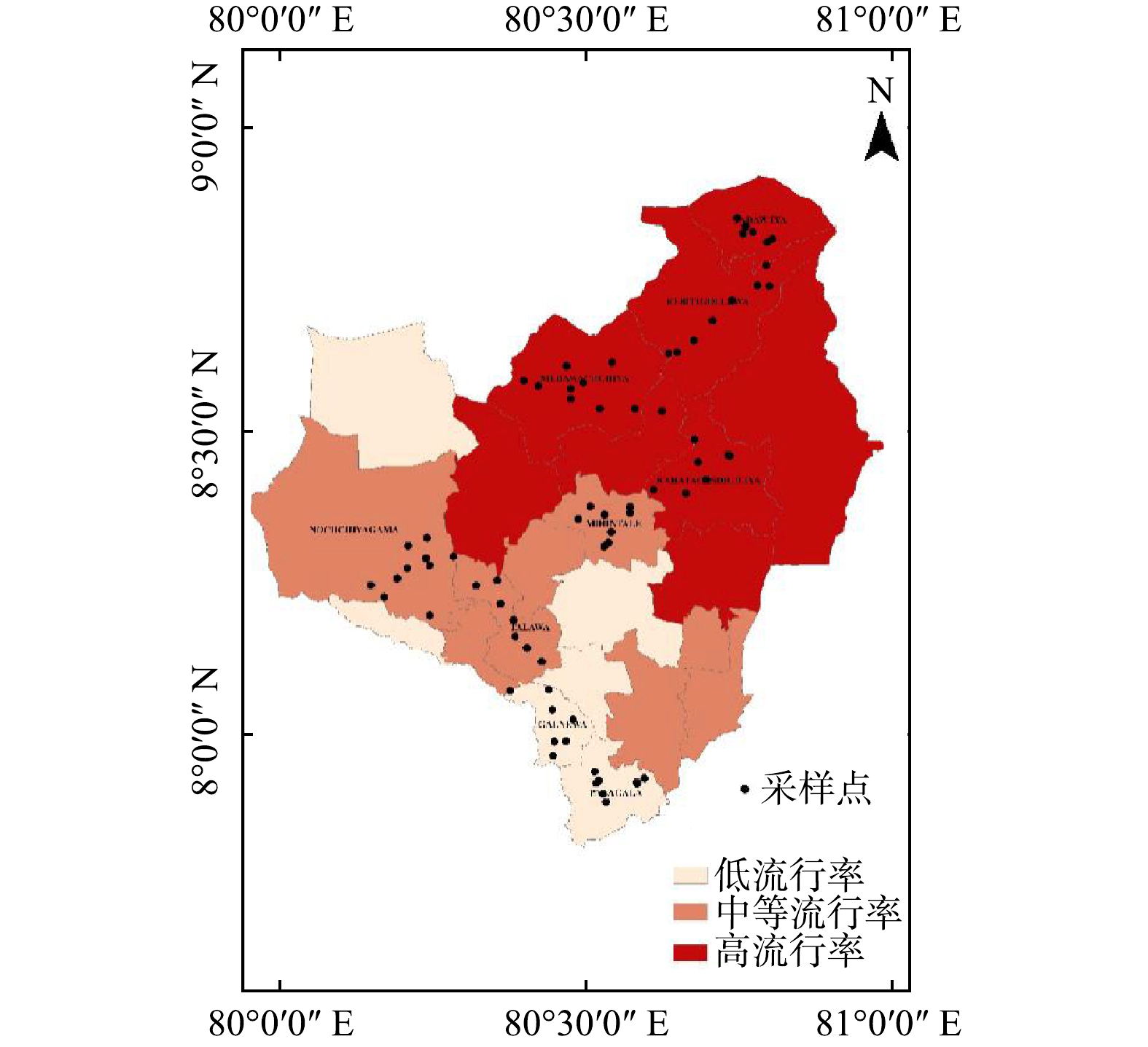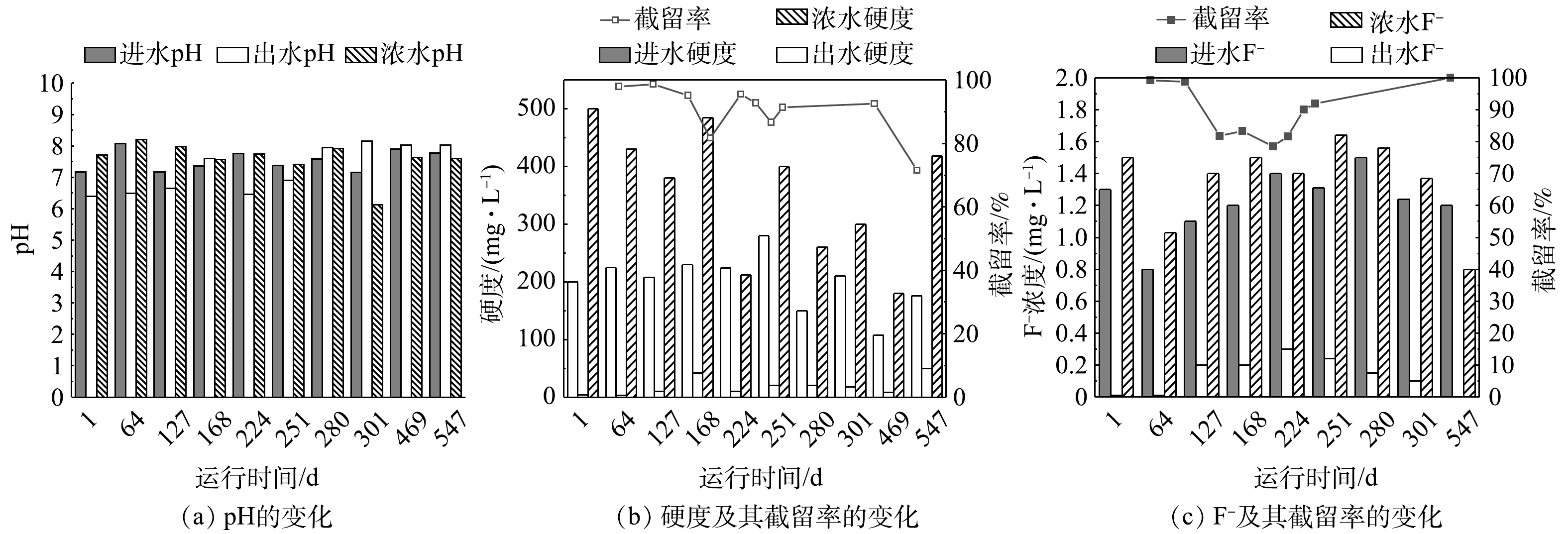-
斯里兰卡地处印度洋的核心区域,是东西方海运的必经之地和“一带一路”沿线的支点国家[1]。20世纪90年代,斯里兰卡北中省(North Central Province, NCP)发现了一种不明原因慢性肾病(chronic kidney diseases of uncertain etiology, CKDu),患者年龄跨度为17~70岁,其中重症患者多为30~60岁的男性农民[2],但其致病原因至今尚不清楚。世界卫生组织(World Health Organization, WHO)研究表明[3],饮用水是影响CKDu的主要因素之一,并推荐为当地居民提供安全饮用水是预防CKDu的一种有效方法。地下水是NCP干区(dry zone)居民最主要的饮用水水源。已有研究表明,硬度、F−和溶解性有机物(dissolved organic matter, DOM)是该地区地下水中最主要的超标污染物[4-5]。据统计,2018年斯里兰卡供水管网覆盖率为50.5%,且主要集中在首都科伦坡和康提等大城市[6];农村地区人口密度低,居住分散,市政管网供水覆盖率低,供水由社区组织(Community Based Organization, CBO)提供[7]。为解决CKDu病区安全饮用水问题,斯里兰卡政府在CKDu病区大力推广应用反渗透(reverse osmosis,RO)膜技术。2016年,CKDu病区已建成700多座RO膜饮用水站[8],处理规模0.5~3 m3·d−1。RO水站主要由砂滤、活性炭、微滤(microfiltration, MF)和RO构成,通常采用间歇操作模式,但存在如下主要问题:1) RO膜高压运行[9]和膜污染[10]造成了水站操作复杂,维护成本高;2) RO膜去除了水中包括单价盐类的绝大部分物质,影响了口感,致使当地民众对RO产水认可度不高;3) 大多数RO水站由个人或CBO运营,其水站运营维护和管理缺乏可遵循的统一规范[11]。因此,CKDu病区迫切需要引入操作简便、易于维护、水质安全可口、经济高效的饮用水处理技术。
本研究通过现场调研,考察旱季和雨季条件下斯里兰卡CKDu病区地下水水质特征,明确主要超标水质参数(硬度、F−和有机碳)的特征,据此开发基于纳滤膜的地下水源饮用水处理技术与设备,以期为斯里兰卡CKDu病区饮用水安全保障提供参考。
全文HTML
-
为调查CKDu病区的地下水水质特征,分别于雨季(2016年12月)和旱季(2017年5月)在斯里兰卡北中省Anuradhapura地区进行水质调查。根据人口和CKDu发病率确定采样点,主要采集浅井、管井及泉水样品,采样点分布如图1所示。高CKDu发病率区的采样点有35个,中CKDu发病率区的采样点有26个,低CKDu发病率区的采样点有17个;在无CKDu病例的Monaragala和Kandy地区各采集5个水样作为空白点。共计采集水样88个。
-
采用便携式水质分析仪(WTW, Welheim, Germany)测量pH值、电导率EC、水温。水样中的金属元素由电感耦合等离子发射光谱(ICP-OES, Optima 2100 DV, Perkin Elmer, USA)和电感耦合等离子体质谱仪仪(ICP-MS, Agilent 8800, Agilent, USA)测定;阴离子由离子色谱(IC, ICS-1000, Di-onex, USA)测定;在此基础上计算硬度浓度(采用钙和镁离子计算,如式(1)所示)。水样中溶解性有机碳(dissolved organic carbon,DOC)的质量浓度通过总有机碳分析仪(TOC, Elementra, Langenselbold, Germany)进行分析。
式中:H为硬度,mg·L−1;
$ {C}_{{\rm{Ca}}} $ 为钙离子质量浓度,mg·L−1;$ {C}_{{\rm{Mg}}} $ 为镁离子质量浓度,mg·L−1。 -
水质调查结果显示,CKDu病区地下水的硬度、F−、DOC质量浓度较高,其分布如图2所示。
如图2(a)和图2(b)所示,在Anuradhapura地区,旱季地下水中硬度较雨季有所升高。雨季地下水硬度均小于350.0 mg·L−1;而旱季地下水中硬度浓度鲜有小于250.0 mg·L−1。在Nochchiyagama、Mihintale和Kahatagasdigiliya地区,地下水中硬度浓度超过350.0 mg·L−1,超标率在50%以上。地下水硬度是指地下水中钙镁离子总浓度,包括碳酸盐硬度和非碳酸盐硬度。Wasana在北中省地下水的水质调查报告中显示[12],高CKDu发病率区和低CKDu发病率区地下水中CaCO3浓度为121~180 mg·L−1,在无CKDu地区,CaCO3浓度则为61 mg·L−1;DHARMA-WARDANA等也报告了类似结果[13]。在采集的24个地下水样品中,有23个样品总硬度(以CaCO3计)超过140 mg·L−1。这表明北中省地下水中硬度是常见超标污染物,这可能是因为北中省在旱季高温少雨,蒸发造成了离子质量浓度的增加[14]。
研究区域内大部分地下水中F−的质量浓度较高,平均浓度超过斯里兰卡饮用水标准(SLS 614-2013)中F−的质量浓度限值2.5倍以上。由图2(c)和图2(d)可知,无论旱季雨季,地下水中F−的质量浓度大部分大于2.0 mg·L−1。在雨季,F−的质量浓度大于3.0 mg·L−1的区域主要是Nochchiyagama地区,而Galanewa和Mihintale部分地区地下水中F−的质量浓度较低(1.49~2.0 mg·L−1);Padawiya、Kebitigollewa和Kahatagasdigiliya部分地区地下水在旱季F−的质量浓度升高,Nochchiyagama地区地下水中F−的质量浓度略下降。在斯里兰卡CKDu病区,很多研究都发现地下水中F−的质量浓度超标[15-16]。CHANDRAJITH等[17]研究发现,在干区大多数地下水中F−的质量浓度高于1.5 mg·L−1,超过50%地下水水井中F−的质量浓度高于1.0 mg·L−1。WICKRAMARATHNA等[18]利用同位素方法分析地下水中的F−,结果显示在依赖地下水为饮用水水源的Girandurukotte,Nikawewa,Medawachchiya和Padaviya地区,地下水中F−的质量浓度分别为2.14、5.30、4.90和1.33 mg·L−1,个别地区F−的质量浓度为5 mg·L−1,均超过斯里兰卡饮用水标准规定的1.0 mg·L−1。因此,气候变化、地下水蒸发及过度取用是F−质量浓度增加的主要原因[14]。
采样区域地下水中DOC分布如图2(e)和图2(f)所示。DOC的质量浓度主要集中在4 mg·L−1以上,极少数地区地下水中DOC的质量浓度小于4 mg·L−1。在雨季,Padawiya和Kebitigollewa地区地下水中DOC的质量浓度为8 mg·L−1,明显高于旱季;相比于雨季,旱季地下水中DOC的质量浓度有所下降。其中,DOC的质量浓度集中在4.0~8.0 mg·L−1。在其他研究中也有关于CKDu病区地下水中DOC质量浓度较高的报告[18]。MADHUBHASHINI等[19-20]在北中省Anuradhapura地区的水质分析结果显示,地下水中DOC分子质量为900~1 800 Da,主要为难生物降解和高芳香性的有机化合物(包括富里酸、色氨酸和络氨酸)。在高CKDu发病率区,地下水中DOC质量浓度为(1.68±0.69) mg·L−1;在无CKDu发病率区,DOC的质量浓度为(2.08±0.74) mg·L−1,而最低DOC的质量浓度出现在低CKDu发病率区,为(1.35±0.17) mg·L−1。
综上所述,Anuradhapura地区地下水中硬度、F−及DOC是CKDu病区常见超标污染物,并随雨季和旱季的转变,地下水水质发生较为明显变化。表明Anuradhapura地区地下水需要经过进一步处理后才可以作为饮用水使用。研究人员采用水质指数分析(water quality index,WQI)对CKDu地下水进行水质评价[21]。在计算WQI值时,将pH、总硬度、F−和DOC等参数考虑在内,结果显示CKDu地区雨季和旱季采集的样品中,分别只有3.8%和2.6%水样水质显示为优良,其余均低于优良水质标准。
1.1. 采样区域
1.2. 水质分析方法
1.3. CKDu水质特征分析
-
基于膜通量、硬度和DOC截留率及运行稳定性等参数的实验室研究结果[4],本研究选择超低压选择性纳滤膜DF-90(DF-90404,北京碧水源)应用于NF膜饮用水站(设计规模20 t·d−1)。由于单一膜处理技术的使用不足以支撑NF膜水站长时间的稳定运行,故饮用水的流程中包含了预处理。多数情况下,选择MF与NF、超滤(ultrafiltration,UF)与NF[22-23]等相结合的膜技术作为预处理步骤,有助于减少膜结垢并延长膜的使用寿命;使用阳离子交换树脂可以减少水中Ca2+和Mg2+,降低膜表面的无机结垢;砂滤器和活性炭吸附也可作为纳滤前的预处理技术,用于去除颗粒和胶体物质。基于以上原理,该纳滤水站的工艺流程示意图如图2所示。NF膜饮用水站采用集成化设计,占地小、方便运输。原水经前置过滤器去除水中较大颗粒,再经由输水管路送至原水箱,进水泵将原水箱内水送至多介质过滤器,利用活性炭和阴离子交换树脂部分去除水中DOC和F−等物质;多介质过滤器出水送至自动软化器,软化器内阳离子交换树脂部分去除原水中钙镁等硬度离子。一、二级精密过滤器采用PP棉,依次去除原水中粒径为10 μm和5 μm的杂质。最后,利用高压泵将处理后的水送至NF膜过滤,产水储存于净水箱(箱内有臭氧发生器,消毒确保水质),经过紫外消毒后取用。考虑到长期运行,为进一步减少膜污染,NF饮用水站设有加药系统和化学清洗系统。加药系统为NF膜投加阻垢剂,防止出现结垢,盐箱用于树脂再生,清洗水箱为预处理单元和NF膜提供化学清洗,延长膜的使用寿命。
该纳滤饮用水站于2018年9月19日在斯里兰卡Anuradhapura的Sirimapura村(纬度−8.159, 经度−80.241/141472E, 328148N)正式投入运行。该村将抽取的地下水输送至15 m高的水塔(有效容积75 m3),通过管道将原水输送至NF膜饮用水站处理。NF膜饮用水站可为该村164户居民(约750人)和附近小学1 300名学生提供优质饮用水。工艺流程如图3所示。
典型RO水站处理工艺一般由砂滤、活性炭、MF和RO膜技术构成,少有消毒过程。进水泵将原水送至砂滤进行预处理,经由活性炭吸附后送至MF膜组件,MF出水由压力泵送至RO膜过滤,产水储存在饮用水箱取用。
-
NF水站的运行压力0.5 MPa,产水量0.85 m3·h−1。根据斯里兰卡国家供排水委员会(National Water Supply and Drainage Board, NWSDB)对该NF水站的水质检测结果,NF水站运行一年多以来,产水水质稳定,且对原水中硬度、F−和DOC保持了较高的去除率,结果如图4所示。
如图4所示,NF水站已运行超过547 d(截至2020年3月13日),产水中pH、硬度和F−等指标基本保持稳定。由图4(a)可知,进水pH为6.5~8,出水pH多为弱碱性(7.0~7.8),浓水的pH为6~8.2;硬度过高会引起饮用水口感较差,造成设备管路堵塞,硬水中的钙离子易与食物中的草酸等发生反应,形成草酸钙、磷酸钙等沉淀,导致肾结石发病率增加[24]。由图4(b)可知,NF水站进水中硬度较高(均大于100 mg·L−1,部分超过280 mg·L−1),产水硬度均小于50 mg·L−1,浓水硬度为200~500 mg·L−1,NF水站对硬度的截留率可达到80%以上,部分可达95%。这表明NF水站去除了大部分Ca2+、Mg2+等离子。长期饮用F−超标的饮用水会导致氟中毒,主要表现为氟斑牙和氟骨症[25]。由图4(c)可知,进水中F−的质量浓度为0.8~1.5 mg·L−1,产水中F−的质量浓度均小于0.3 mg·L−1,浓水F−的质量浓度大于1.0 mg·L−1,NF水站对F−的截留率在85%以上,部分可达到95%。这表明NF水站可有效去除F−。由于斯里兰卡当地缺少DOC检测设备,因此日常监测过程中并未对水中DOC进行监测。本研究将NF水站产水样品带回中国进行分析,结果显示,经NF水站处理后,原水中的DOC几乎被完全去除。
综上所述,本研究以NF膜技术为核心的饮用水水站,在CKDu病区地下水的水质复杂和波动情况下,不仅有效降低了水中的硬度、F−的质量浓度和TOC等指标,而且保留了一部分人体所需的矿物质和微量元素,获得了优质安全的饮用水,满足了当地民众的安全饮用水需求。
-
CKDu病区RO水站的日常管理和运营由个人或社区组织负责。例如,斯里兰卡海军运营的RO水站为民众免费提供饮用水,其他个人和CBO管理的RO水站,水的售价为每升0~0.16 元不等。而NF水站产水的售价为0.04 元,故NF水站产水的价格在当地民众中接受率高。另外,RO水站需每天进行人工反冲洗,NF水站的日常维护过程则为自动化,这也极大地减少了人为因素引起的操作问题。考虑到水压及长期运行,NF水站将水回收率设置为40%。
为比较RO水站与NF水站的产水水质,本研究分别从Medawacchiya、Thirappane、Monragala1、Monragala、Monragala、Monragala、Palagala、Rajangaaya等8个区域收集了RO水站的产水,并与NF水站的产水进行对比(见表1)。大多数RO水站产水pH为弱酸性。长期饮用弱酸性饮用水会破坏人体pH酸碱平衡,导致免疫力下降,从而进一步引发各类疾病[26]。同时,RO水站的产水几乎完全去除了离子,而NF水站降低了水中大部分硬度、F−质量浓度和DOC,保留了一部分人体所必需矿物质,而浓水用做建筑和灌溉用水,节约了后续处理成本。
综上所述,NF水站达到了预期设计目标,为该地区人民提供了安全优质的饮用水。然而,尽管NF水站的设计处理规模为20 t·d−1,但由于当地居民居住分散,加之交通不便,水站覆盖范围有限等原因,NF水站实际产水仅为1.5 t·d−1。因此,下一步可因地制宜,建造更加小型的NF水站或户用纳滤饮水设备,以便能更好地解决当地饮用水问题。
2.1. 纳滤饮用水站
2.2. 纳滤膜饮用水站运行效果
2.3. 纳滤膜饮用水站与反渗透膜饮用水站的比较
-
1)斯里兰卡北中省CKDu病区地下水水质调查结果表明,该地区地下水的主要水质问题是硬度、氟化物和DOC等指标较高,超过了斯里兰卡饮用水标准(SLS 614-2013)。
2)以纳滤膜技术为核心开发了地下水源饮用水处理技术与设备,并在斯里兰卡CKDu病区建设了一座NF水站。水站的水质监测结果表明,运行一年多以来,NF水站性能稳定,运行状况良好,产水符合斯里兰卡国家饮用水标准(SLS 614-2013)。NF水站具有易于操作、便于维护、产水水质优异等优点,产水呈弱碱性(pH=7.3),且能保留一部分对人体有益的矿物质。




 下载:
下载:







